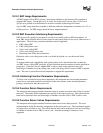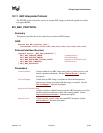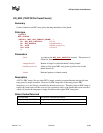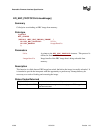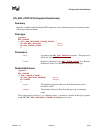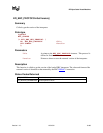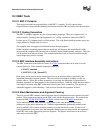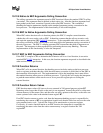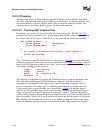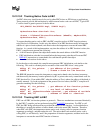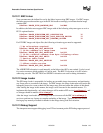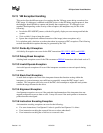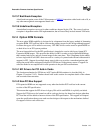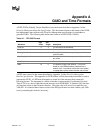
Extensible Firmware Interface Specification
19-70 12/01/02 Version 1.10
19.12 EBC Tools
19.12.1 EBC C Compiler
This section describes the responsibilities of the EBC C compiler. To fully specify these
responsibilities requires that the thunking mechanisms between EBC and native code be described.
19.12.2 C Coding Convention
The EBC C compiler supports only the C programming language. There is no support for C++,
inline assembly, floating point types/operations, or C calling conventions other than CDECL.
Pointer type in C is supported only as 64-bit pointer. The code should be 64-bit pointer ready (not
assign pointers to integers and vice versa).
The compiler does not support user-defined sections through pragmas.
Global variables containing pointers that are initialized will be put in the uninitialized VarBss
section and the compiler will generate code to initialize these variables during load time. The code
will be placed in an init text section. This compiler-generated code will be executed before the
actual image entry point is executed.
19.12.3 EBC Interface Assembly Instructions
The EBC instruction set includes two forms of a CALL instruction that can be used to invoke
external protocols. Their assembly language formats are:
CALLEX Immed64
CALLEX32 {@}R
1
{Immed32}
Both forms can be used to invoke external protocols at an absolute address specified by the
immediate data and/or register operand. The second form also supports jumping to code at a
relative address. When one of these instructions is executed, the interpreter is responsible for
thunking arguments and then jumping to the destination address. When the called function returns,
code begins execution at the EBC instruction following the CALL instruction. The process by
which this happens is called thunking. Later sections describe this operation in detail.
19.12.4 Stack Maintenance and Argument Passing
There are several EBC assembly instructions that directly manipulate the stack contents and stack
pointer. These instructions operate on the EBC stack, not the interpreter stack. The instructions
include the EBC PUSH
, POP, PUSHn, and POPn, and all forms of the MOV instructions.
These instructions must adjust the EBC stack pointer in the same manner as equivalent
instructions of the native instruction set. With this implementation, parameters pushed on the
stack by an EBC driver can be accessed normally for stack-based native code. If native code
expects parameters in registers, then the interpreter thunking process must transfer the arguments
from EBC stack to the appropriate processor registers. The process would need to be reversed
when native code calls EBC.



